PDF:  download |
download |  view
view
VISUAL GUIDE TO THE VEHICLE PRE-INSURANCE
PHOTO INSPECTION PROCESS
Graphic Requirements for Vehicle Physical Damage Inspection Reports
Visual documentation, whether it is digital or conventional photography, is an integral aspect of the vehicle inspection process. The inspection report, along with appropriate digital or photographic images provides valuable information about the inspected vehicle in accordance with state-mandated requirements. Included in the many benefits of the inspection process are:

 Verification of the VIN and proof a vehicle actually exists.
Verification of the VIN and proof a vehicle actually exists.
 Record of the vehicle's physical condition.
Record of the vehicle's physical condition.
 Documentation of on-board options and accessories.
Documentation of on-board options and accessories.
Pre-insurance inspection consists of a detailed visual inspection and photographic documentation:
1. Visual Inspection
Vehicle is examined by an authorized inspector who checks for equipment [options], anti-theft systems, rust and existing physical damage. The information is recorded on an inspection report form, which includes the insured's name, Vehicle Identification Number [VIN] and description of the vehicle.
2. Visual Documentation
Two color photographs [digital or Polaroid images] are taken at oblique angles from the front and rear, resulting in a graphic record that clearly shows the vehicle's four sides. A third image is taken of the Federal Vehicle Safety Standard Certification Label, usually located on the driver's door or door post, using a digital camera or Polaroid instant camera equipped with a special close-up hood. If extensive damage is found, additional photos may be required.
The Safety Certification Label, often referred to as the EPA Label, includes the Vehicle Identification Number, or VIN. The EPA Label photo is an important part of the documentation package and a valuable investigative tool, with information that provides the means to check the vehicle's authenticity, identify vehicles that do not comply with U.S. safety standards, and the means to detect salvaged and stolen vehicles.
A. Front/ Driver's Side
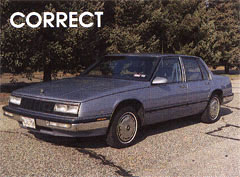 |
 Correct: Front 3/4 - view, taken from the driver's side of the vehicle, must clearly show the front of the vehicle including the full bumper, and the driver's side. A simple, clutter-free background is desirable for both front and rear images. Correct: Front 3/4 - view, taken from the driver's side of the vehicle, must clearly show the front of the vehicle including the full bumper, and the driver's side. A simple, clutter-free background is desirable for both front and rear images. |
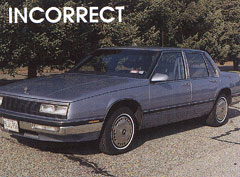 |
 Incorrect: Because the picture shown was taken too close to the car, part of the front bumper has been cut off Incorrect: Because the picture shown was taken too close to the car, part of the front bumper has been cut off |
B. Rear/ Passenger Side
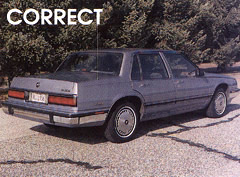 |
 Correct: Rear 3/4 - view shows back of car, including rear bumper and passenger side. Correct: Rear 3/4 - view shows back of car, including rear bumper and passenger side. |
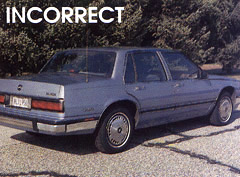 |
 Incorrect : Picture was taken too close to the car, cutting off part of rear bumper. Incorrect : Picture was taken too close to the car, cutting off part of rear bumper. |
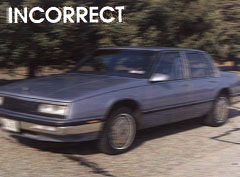 |
 Incorrect: Camera movement can produce a blurred image, which obscures important details. Incorrect: Camera movement can produce a blurred image, which obscures important details. |
Safety Certification Label Photo [Digital or Polaroid Images]
The easy-to-use digital cameras generally used by CARCO inspectors are capable of taking close-up images of the EPA Label without special attachments. In cases where Polaroid instant cameras are used, a special Polaroid camera hood is used to produce accurate photographs.
For best results:
 Label being photographed must be dry; wet surfaces can cause reflections.
Label being photographed must be dry; wet surfaces can cause reflections.
 Digital camera: image should be centered in viewing screen.
Digital camera: image should be centered in viewing screen.
 Polaroid camera: close-up hood should be centered over label; camera's light/dark control should be in the "Normal" position.
Polaroid camera: close-up hood should be centered over label; camera's light/dark control should be in the "Normal" position.
 Camera's Flash should be ON
Camera's Flash should be ON
Physical Damage
The picture shown (above left), taken from too great a distance, does not show the extent of body damage indicated on the inspection report. The picture should be taken from a much closer distance to the vehicle (above right). Close-up photographs provide meaningful visual records and are valuable in depicting pre-existing physical damage.
For additional information about CARCO Group Inc. and its insurance-related services, contact:
Michael Greve
Inspection Services
CARCO Group Inc.
17 Flowerfield Industrial Park
St. James, NY 11780
e-mail: phoffman@carcogroup.com
Tel: (516) 862-9300
Tel: (800) 969-2272




